Contents
Introduction
Many parents find comfort and joy in cuddling their babies and allowing them to sleep on their chests. However, it’s important to understand the safety considerations associated with this sleeping position. In this article, we will explore the topic of a baby sleeping upright on the chest, discussing the potential risks, benefits, and guidelines to ensure the safety and well-being of both the baby and the caregiver.
Potential Risks of Baby Sleeping Upright on the Chest
While it may seem cozy and soothing to have a baby sleep on your chest, there are several risks to consider:
- Suffocation Hazard: Placing a baby in an upright position on the chest can increase the risk of suffocation, especially if the baby’s face becomes buried in blankets, clothing, or against the caregiver’s body.
- Restricted Breathing: The position of a baby’s head on the caregiver’s chest can sometimes restrict their airway, making it more difficult for the baby to breathe freely.
- Overheating: The warmth and proximity of the caregiver’s body can cause the baby to overheat, leading to discomfort and potential health risks.
Safety Considerations for Baby Sleeping Upright on the Chest
If you choose to allow your baby to sleep upright on your chest, it’s crucial to follow these safety guidelines:
- Supervision: Never leave a baby unattended when sleeping on your chest. The caregiver should remain awake and alert to monitor the baby’s position and well-being.
- Eliminate Suffocation Hazards: Ensure there are no loose blankets, pillows, or clothing that could cover the baby’s face. Maintain a clear and open airway at all times.
- Safe Sleep Surface: Use a firm mattress or surface for the caregiver to lie on. Avoid soft or unstable surfaces that could potentially pose a risk to the baby’s safety.
- Proper Positioning: Place the baby’s head higher than the caregiver’s chest to allow for better breathing. Keep the baby’s face uncovered and ensure their airway remains clear.
- Temperature Control: Be mindful of the ambient temperature and ensure that both the caregiver and the baby are comfortable and not overheating. Dress the baby in appropriate clothing for the room temperature.
Alternatives for Safe Sleep
While many parents enjoy the closeness and bonding of having their baby sleep on their chest, there are alternative safe sleep options to consider:
- Bassinet or Crib: Use a bassinet or crib that meets safety standards, with a firm mattress and a fitted sheet. This provides a dedicated sleep space for the baby, reducing the risk of suffocation and providing a safe sleep environment.
- Co-Sleeping with Safety Measures: If you prefer to have the baby close by, consider co-sleeping using a co-sleeper bassinet or a sidecar arrangement that attaches securely to the adult bed. This allows for proximity while maintaining separate sleeping surfaces for the caregiver and the baby.
- Skin-to-Skin Contact: If you desire the benefits of close contact and bonding, opt for skin-to-skin contact while the baby is awake and being held, rather than during sleep. This reduces the risks associated with sleep-related positions.
Frequently Asked Questions (FAQs)
Q: Is it safe for a baby to sleep on the chest during naps?
A: The same safety considerations apply to daytime naps as they do for nighttime sleep. It’s important to closely supervise the baby and follow safe sleep practices to mitigate the risk of suffocation and ensure their safety.
Q: Can I use a baby carrier or sling for upright sleep on the chest?
A: No, baby carriers and slings are not designed or recommended for sleep. They can pose suffocation hazards and compromise the baby’s airway. Use carriers and slings for awake and supervised activities only.
Q: What are the signs of overheating in a baby?
A: Signs of overheating in a baby include sweating, flushed skin, rapid breathing, restlessness, and discomfort. Ensure the baby is dressed appropriately for the room temperature and monitor their comfort levels.
Q: When should I transition my baby to their crib or bassinet?
A: Transitioning to a crib or bassinet depends on the baby’s developmental milestones and the guidance of your pediatrician. Typically, it is recommended to transition the baby to their own sleep space around 3 to 6 months of age.

Conclusion
While the idea of a baby sleeping upright on the chest may seem comforting, it’s important to prioritize safety and consider the potential risks involved. Always adhere to safe sleep practices, supervise the baby closely, and create a secure sleep environment. Remember, there are alternative safe sleep options available that allow for closeness and bonding while minimizing potential hazards. By making informed choices, you can ensure the safety and well-being of your baby during sleep.

 Subscribe to Get Soothing Lullabies to Help Your Baby to Sleep
Subscribe to Get Soothing Lullabies to Help Your Baby to Sleep
1 comment
[…] Baby Sleeping Upright on Chest: Exploring Safety and Considerations […]